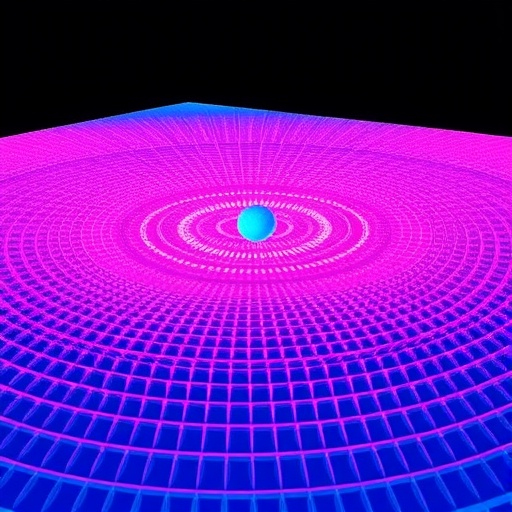Researchers Push the Frontiers of Optical Imaging with Wafer-Scale Multi-Layer Diffractive Processors
In a groundbreaking advancement that could redefine the landscape of optical imaging, a team of scientists has unveiled a revolutionary method for broadband unidirectional visible imaging utilizing wafer-scale nano-fabrication of multi-layer diffractive optical processors. This technique, detailed in a recent publication in Light: Science & Applications, paves the way for ultra-compact, efficient, and scalable optical devices capable of manipulating light with unprecedented precision across the visible spectrum. By integrating multi-layer diffractive structures fabricated at wafer scale through advanced nanofabrication methods, the researchers have addressed longstanding challenges in optical computing and imaging, promising mainstream applications ranging from microscopy to augmented reality.
Traditional optical imaging systems have often grappled with trade-offs involving device size, spectral bandwidth, directionality, and manufacturing scalability. Conventional lenses and optical components tend to be bulky and are limited by chromatic aberrations when attempting broadband imaging. Moreover, producing advanced nanophotonic devices with high uniformity over large areas has posed significant technical hurdles. This newly introduced approach synthesizes multi-layer diffractive optics fabricated on semiconductor wafers using state-of-the-art lithographic techniques, thereby enabling high-throughput mass production without compromising on optical performance.
.adsslot_CdRY3mwlhq{ width:728px !important; height:90px !important; }
@media (max-width:1199px) { .adsslot_CdRY3mwlhq{ width:468px !important; height:60px !important; } }
@media (max-width:767px) { .adsslot_CdRY3mwlhq{ width:320px !important; height:50px !important; } }
ADVERTISEMENT
At the core of this innovation lies the design philosophy of multi-layer diffractive optical processors that sculpt and guide visible light through carefully engineered nanoscale features. By stacking several thin diffractive layers, each designed to perform specific phase and amplitude manipulations, the system collectively achieves complex optical computations. This multi-layer architecture enhances the degrees of freedom available for light control, allowing for broadband operation and unidirectional imaging, which are notoriously difficult to realize using single-layer or bulky conventional elements.
The wafer-scale fabrication process represents a critical enabler for this technology’s scalability and integration into practical devices. Utilizing nanolithography and advanced etching methods, the team has demonstrated the ability to pattern these multi-layer diffractive components across full semiconductor wafers with nanoscale precision and reproducibility. This breakthrough overcomes past limitations where diffractive elements were restricted to small areas or required laborious serial writing methods, thus limiting widespread adoption in commercial markets.
Broadband operation is a highlight of this diffractive imaging strategy. Conventional photonic devices have historically been wavelength-specific, constraining them to narrow spectral bands. By optimizing the layer design and material selection, the researchers have engineered a device capable of maintaining consistent performance over the entire visible range. This broadband capability unlocks versatility for applications requiring natural color imaging or multiwavelength light processing, such as in biological microscopy, environmental sensing, or consumer electronics.
Another pivotal aspect is the unidirectionality of imaging enabled by this approach. Many optical elements suffer from back reflections or bidirectional scattering, which reduce image contrast and complicate system design. The multi-layer diffractive processor inherently favors forward transmission of light with optimized efficiency and minimal loss, resulting in clearer, higher-fidelity images. Such directionality is essential for advanced imaging tasks where controlling stray light and maximizing signal-to-noise ratios are crucial.
The potential implications of this technology span numerous fields. In microscopy, the ability to fabricate ultra-thin, wafer-scale optical elements that perform complex light transformations could drastically reduce instrument sizes while enhancing resolution and color fidelity. Consumer devices like smartphones and augmented reality headsets stand to benefit as the miniaturized diffractive processors can replace bulky lens stacks, culminating in slimmer, lighter optics without compromising visual quality.
Moreover, the compatibility of these diffractive processors with established semiconductor manufacturing lines means that integration with existing electronics and image sensors is feasible. This opens possibilities for on-chip optical signal processing and edge computing, where light manipulation and computation happen simultaneously within a compact footprint. Such devices could spearhead advances in smart cameras, autonomous navigation, and even quantum information technologies where precise control of photonic states is paramount.
From a technical perspective, the research team employed sophisticated optimization algorithms to design the multi-layer phase profiles that can tailor light propagation efficiently. The iterative computational methods account for physical constraints such as fabrication tolerances and material dispersion, ensuring robust performance in realistic conditions. Experimental validation confirmed that the fabricated devices met theoretical predictions, demonstrating high diffraction efficiencies and spectral uniformity.
Challenges remain, particularly in further boosting efficiency, reducing insertion losses, and scaling to even larger wafer sizes or flexible substrates. However, the demonstrated proof-of-concept affirms that multi-layer diffractive processors can serve as versatile building blocks for future optical systems. By harnessing the synergy between nanofabrication precision and optical engineering, this work charts a compelling path forward for integrated photonics.
In essence, this breakthrough represents more than a technical feat; it embodies a paradigm shift toward flat optics that blend functionality with manufacturability. As the photonics community rushes toward miniaturization and integration, multilayer diffractive processors fabricated at wafer scale stand as a beacon for the next generation of optical imaging technologies. Their potential to replace traditional bulky optics with compact, efficient, and broadband devices heralds a new era in visual science.
Future research will likely explore hybrid platforms combining these diffractive processors with emerging materials like metasurfaces or active tunable layers for dynamic control of light. Investigating novel material systems could help circumvent current physical limitations and push operational regimes beyond visible wavelengths into infrared or ultraviolet spectra. Cross-disciplinary efforts merging computational design, materials science, and fabrication will be vital to unlocking the full scope of applications.
Article Title: Broadband unidirectional visible imaging using wafer-scale nano-fabrication of multi-layer diffractive optical processors
Article References:
Shen, CY., Batoni, P., Yang, X. et al. Broadband unidirectional visible imaging using wafer-scale nano-fabrication of multi-layer diffractive optical processors. Light Sci Appl 14, 267 (2025). https://doi.org/10.1038/s41377-025-01971-2
Image Credits: AI Generated
DOI: https://doi.org/10.1038/s41377-025-01971-2
Tags: advanced nanofabrication methodsaugmented reality applicationsbroadband optical imagingcompact optical deviceshigh-throughput mass productionmicroscopy innovationsmulti-layer diffractive processorsoptical computing advancementssemiconductor wafer technologyunidirectional imaging technologyvisible spectrum manipulationwafer-scale nano-fabrication





